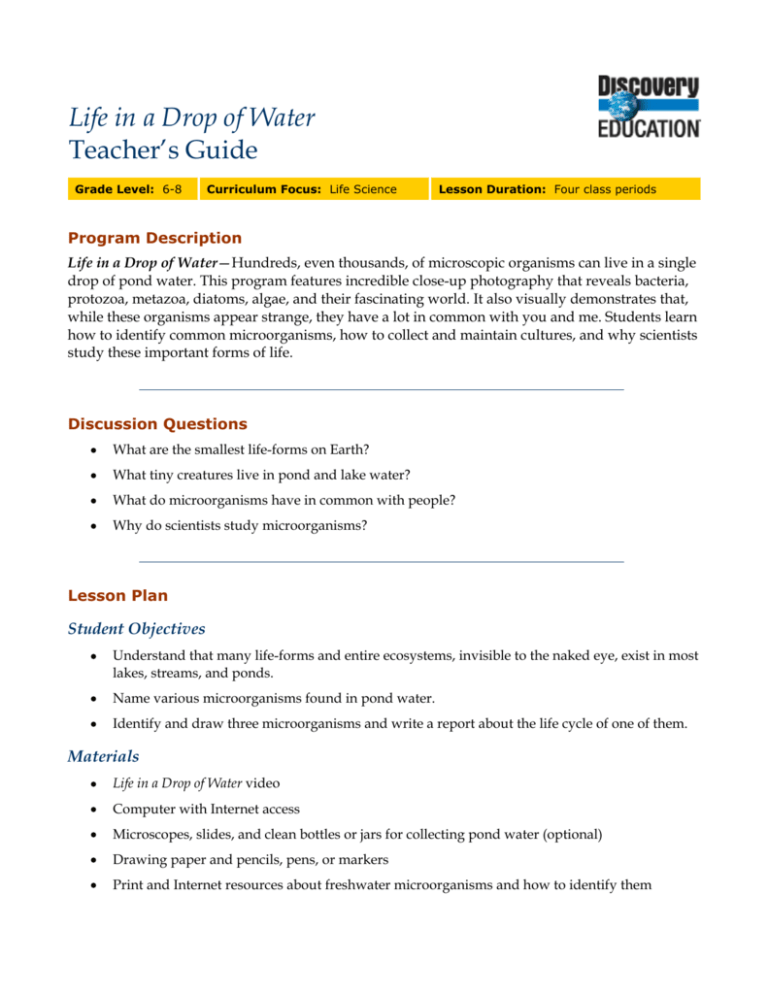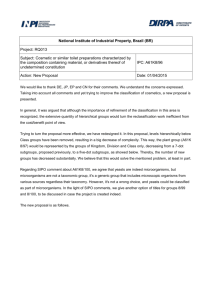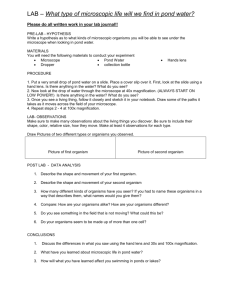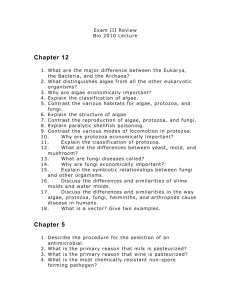
Life in a Drop of Water
Teacher’s Guide
Grade Level: 6-8
Curriculum Focus: Life Science
Lesson Duration: Four class periods
Program Description
Life in a Drop of Water—Hundreds, even thousands, of microscopic organisms can live in a single
drop of pond water. This program features incredible close-up photography that reveals bacteria,
protozoa, metazoa, diatoms, algae, and their fascinating world. It also visually demonstrates that,
while these organisms appear strange, they have a lot in common with you and me. Students learn
how to identify common microorganisms, how to collect and maintain cultures, and why scientists
study these important forms of life.
Discussion Questions
•
What are the smallest life-forms on Earth?
•
What tiny creatures live in pond and lake water?
•
What do microorganisms have in common with people?
•
Why do scientists study microorganisms?
Lesson Plan
Student Objectives
•
Understand that many life-forms and entire ecosystems, invisible to the naked eye, exist in most
lakes, streams, and ponds.
•
Name various microorganisms found in pond water.
•
Identify and draw three microorganisms and write a report about the life cycle of one of them.
Materials
•
Life in a Drop of Water video
•
Computer with Internet access
•
Microscopes, slides, and clean bottles or jars for collecting pond water (optional)
•
Drawing paper and pencils, pens, or markers
•
Print and Internet resources about freshwater microorganisms and how to identify them
Life in a Drop of Water
Teacher’s Guide
2
Procedures
1. Review information from the video with the class.
•
What do we call a life-form that is so small we need to look at it through a microscope in
order to see it? (a microorganism)
•
How many microorganisms can live in one drop of water? (hundreds or even
thousands)
•
What do humans have in common with the smallest microorganisms? (We are all made
of cells.)
•
What is a cell? (the basic unit of which all living things are composed)
•
How many cells does it take to make a living organism? (Single-celled microorganisms
have only one cell; larger organisms can have billions.)
•
How many cells are there in a human body? (billions)
•
What parts do all cells contain, regardless of what organism they belong to? (a nucleus,
the control center of the cell; a substance called cytoplasm surrounding the nucleus,
where many cell functions occur; a membrane, the sack-like container that holds the cell
together)
•
What are the smallest microorganisms you can see with an ordinary microscope?
(bacteria)
•
Why are bacteria important? (They are an essential food for other microorganisms.)
•
What is another important food source for many pond organisms? (algae)
•
What are algae? (plantlike organisms that appear in a variety of forms and belong to a
larger group of organisms called protists)
•
What are protists? (Protists belong to a group of organisms that are neither plant nor
animal.)
•
How do algae obtain their food? (through photosynthesis)
•
What is photosynthesis? (a process by which plants and algae convert water and carbon
dioxide into food using the energy of sunlight)
•
What is the green substance found in most algae? (chlorophyll)
•
What are clusters of algae called? (colonies)
•
What are protists that possess flagella called? (flagellates)
•
What are protozoa and what does their name mean? (Protozoa are common one-celled
organisms found in pond water; their name means “first animals.”)
•
What are protozoa that possess cilia called? (ciliates)
Published by Discovery Education. © 2005. All rights reserved.
Life in a Drop of Water
Teacher’s Guide
3
•
What structures in protozoa allow them to take in and expel water? (contractile
vacuoles)
•
How do most protozoa reproduce? (through fission)
•
What is the name of the process during which protozoa exchange cell material?
(conjugation)
•
What is the enclosure a protozoan forms when it enters a state of suspended animation?
(a cyst)
•
How does an amoeba move? (by sending out streams of cytoplasm called pseudopods)
•
What are the bubbles that protozoa form to surround food? (food vacuoles)
•
In what ways are protists important? (They form the bottom of the food chain; some are
responsible for producing most of the air we breathe; many are used in scientific studies;
some are carriers of disease.)
2. Ask students to name some of the microorganisms they might find in a drop of pond water.
Record their responses and read any below not offered by students.
•
bacteria
•
algae
•
protozoa
•
paramecium
•
blepharisma
•
spirostomum
•
dileptus
•
stentor
•
lacrymaria olor
•
vorticella
•
bursaria
•
didinium
•
amoebas
•
rotifers
•
daphnia (water flea)
•
cyclops
•
hydras
•
giardia
Published by Discovery Education. © 2005. All rights reserved.
Life in a Drop of Water
Teacher’s Guide
4
3. Challenge students to learn more about the microorganisms in pond water. Activity Option One
(for use when classroom microscopes are available and pond water can be collected): Supply the
students with clean bottles or jars and take a field trip to a pond to observe any visible signs of
life, such as pond scum or algae. Collect samples of clear water. Back in the classroom, have
students prepare microscope slides with the pond water they collected and study the slides
under their microscopes. Tell them to identify at least three of the organisms on their slides by
finding detailed microscopic photographs of various microorganisms in print and on the Web.
Activity Option Two: Have students use print and Web resources to find detailed microscopic
photographs of various microorganisms. Ask them to choose three they would like to study
further. The following Web sites are good starting points:
•
Micro*Scope
http://starcentral.mbl.edu/mv5d/portal/index.php?option=com_azorganism&Itemid=56
•
Cells Alive!
http://www.cellsalive.com/
•
Microscope Forum: Digital Image Galleries
http://www.microimaging.ca/forum.htm
•
Protists
http://www.microbe.org/microbes/protists1.asp
•
What is a Microbe?
http://www.microbe.org/microbes/what_is.asp
•
Amoebas Are More Than Blobs
http://www/microscopy-uk.org.uk/mag/artsep01/amoeba.html
•
Protist Images and Information
http://megasun.bch.umontreal.ca/protists/gallery.html
•
Zoo Lab: Protozoan Form and Function
http://bioweb.uwlax.edu/zoolab/Table_of_Contents/Lab-2b/lab-2b.htm
•
Microbes in Drinking Water
http://www.waterbornediseases.org/FactSheets/microbes.htm
•
Waterborne Pathogens and the Diseases They Cause
http://www.microbeworld.org/htm/cissues/waterq/wqual_1.htm
4. When students have identified or chosen three microorganisms for further study, ask them to
draw realistic, detailed illustrations of each one, labeling its various parts and the function of
each part. Then ask them to choose one of the three microorganisms they have drawn, research
it further, and write a one-page report explaining its life cycle. Tell them the report should
answer these questions: What is the name of the microorganism? To what larger family of
organisms does it belong? Where does it grow? Does it have only one cell or is it a multi-cellular
Published by Discovery Education. © 2005. All rights reserved.
Life in a Drop of Water
Teacher’s Guide
5
organism? How does it eat? What does it eat? What eats it? How does it reproduce? What other
interesting facts have you learned about it?
5. Have students choose partners. Ask them to share their life cycle reports and illustrations with
their partners and answer any questions. Then have each student summarize his or her
partner’s report for the class, using the illustration to help explain it and mentioning at least
three interesting facts.
Assessment
Use the following three-point rubric to evaluate students’ work during this lesson.
•
3 points: Students were highly engaged in class discussions; produced high-quality
illustrations and a complete report, including all of the requested information; accurately
summarized partner’s report and illustration and cited at least three interesting facts.
•
2 points: Students participated in class discussions; produced adequate illustrations and an
adequate report, including most of the requested information; satisfactorily summarized
partner’s report and illustration and cited two interesting facts.
•
1 point: Students participated minimally in class discussions; created unsatisfactory
illustrations and an incomplete report with little or none of the requested information; were
unable to summarize partner’s report, discuss the illustration, or recall any interesting facts.
Vocabulary
algae
Definition: Microscopic, plantlike organisms
Context: Algae appears in a variety of forms.
amoeba
Definition: Among the best known type of protozoa
Context: The stream of cytoplasm an amoeba sends out is called a pseudopod, which means
false foot.
bacteria
Definition: The smallest organisms visible with an ordinary microscope
Context: Bacteria provide food for many other microorganisms.
cell membrane
Definition: The sack-like container that holds a cell together and gives it shape
Context: The cell membrane controls what goes into and comes out of a cell.
cells
Definition: The tiny uniform structures of which all living things are composed
Published by Discovery Education. © 2005. All rights reserved.
Life in a Drop of Water
Teacher’s Guide
6
Context: The cells that make up a human being have much in common with single-cell
microscopic creatures.
chlorophyll
Definition: A green substance in plants that is similar to blood in animals
Context: Like plants, most algae are filled with chlorophyll.
cilia
Definition: Short, hairlike strands used by some protozoa to move
Context: A protozoan that has cilia on any part of its body is called a ciliate.
conjugation
Definition: The action of two microscopic organisms joining at the sides in order to exchange cell
material
Context: Conjugation enables organisms to live longer and to better adapt to their environment.
contractile vacuoles
Definition: Round structures on the interior of a protozoan that open and close
Context: Contractile vacuoles work like pumps to maintain the proper amount of water within a
protozoan.
cyst
Definition: A state of suspended animation in which protozoa resemble spheres
Context: Many protozoa form cysts to enable themselves to survive unfavorable conditions, such
as drought.
cytoplasm
Definition: Fluid substance surrounding the nucleus of a cell
Context: Many cell reactions occur within its cytoplasm.
diatoms
Definition: Organisms closely related to algae
Context: Diatoms have hard outer walls and are found in both freshwater and oceans.
euglenas
Definition: Protists filled with green chlorophyll, closely related to algae
Context: Euglenas rely on photosynthesis to obtain much of their food.
fission
Definition: The process through which some microscopic organisms reproduce themselves by
dividing
Context: A paramecium can reproduce through fission up to three times a day.
Published by Discovery Education. © 2005. All rights reserved.
Life in a Drop of Water
Teacher’s Guide
7
flagella
Definition: The thin, barely visible tails some microscopic animals use to propel themselves
through water
Context: Protists that possess flagella are called flagellates.
food vacuole
Definition: A bubble an amoeba forms around its food
Context: If you examine an amoeba’s cytoplasm, you might see still-living organisms struggling
inside a food vacuole.
nucleus
Definition: The control center of a living cell
Context: The nucleus controls all of a cell’s activities, including reproduction.
oral groove
Definition: A channel some microscopic organisms have along the sides of their bodies,
that directs food into their gullet or stomach
Context: Paramecia have oral grooves instead of mouths.
photosynthesis
Definition: A process by which plants convert water and carbon dioxide into food
Context: Like plants, algae produce food by photosynthesis.
protists
Definition: Organisms that are neither plant nor animal
Context: Algae belong to a larger group of organisms called protists.
protozoa
Definition: Common one-celled organisms found in freshwater
Context: There are thousands of different kinds of protozoa.
Academic Standards
National Academy of Sciences
The National Academy of Sciences provides guidelines for teaching science in grades K–12 to
promote scientific literacy. To view the standards, visit this Web site:
http://books.nap.edu/html/nses/html/overview.html#content.
This lesson plan addresses the following national standards:
•
Life Science: Structure and function in living systems; Reproduction and heredity;
Regulation and behavior; Populations and ecosystems; Diversity and adaptations of
organisms
Published by Discovery Education. © 2005. All rights reserved.
Life in a Drop of Water
Teacher’s Guide
•
8
Science as Inquiry: Abilities necessary to do scientific inquiry; Understandings about
scientific inquiry
Mid-continent Research for Education and Learning (McREL)
McREL’s Content Knowledge: A Compendium of Standards and Benchmarks for K–12 Education
addresses 14 content areas. To view the standards and benchmarks, visit
http://www.mcrel.org/compendium/browse.asp.
This lesson plan addresses the following national standards:
•
Science—Life Sciences: Understands the principles of heredity and related concepts;
Understands the structure and function of cells and organisms; Understands relationships
among organisms and their physical environment; Understands biological evolution and
the diversity of life
•
Science—Nature of Science: Understands the nature of scientific knowledge; Understands
the nature of scientific inquiry
•
Language Arts—Viewing: Uses viewing skills and strategies to understand and interpret
visual media
Support Materials
Develop custom worksheets, educational puzzles, online quizzes, and more with the free teaching tools
offered on the DiscoverySchool.com Web site. Create and print support materials, or save them to a
Custom Classroom account for future use. To learn more, visit
http://school.discovery.com/teachingtools/teachingtools.html.
Credit
Renne Leatto, education and curriculum writer
Published by Discovery Education. © 2005. All rights reserved.








